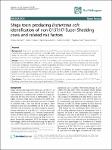Shiga toxin producing Escherichia coli: identification of non-O157:H7-Super-Shedding cows and related risk factors
Menrath, Andrea
Wieler, Lothar H.
Heidemanns, Katrin
Semmler, Torsten
Fruth, Angelika
Kemper, Nicole
Background: Shiga toxin producing Escherichia coli (STEC) are an important cause of human gastro-enteritis and extraintestinal sequelae, with ruminants, especially cattle, as the major source of infection and reservoir. In this study, the fecal STEC shedding of 133 dairy cows was analyzed over a period of twelve months by monthly sampling with the aim to investigate shedding patterns and risk factors. Results: Overall, 24.7% (in total 407) of 1,646 fecal samples were tested positive for stx by PCR with inner-herd prevalences on the different farms of 11.1% to 32.3%. At individual levels, cows were stx-positive on zero to eight consecutive samplings. According to a strictly longitudinal definition of Super-Shedding, in the present study 14 cows were identified as Super-Shedders of non-O157 serotypes. Significant risk factors for the shedding of STEC were the month of sampling, the number of lactations and days in lactation, the nutritional condition, the somatic cell count and the content of protein in milk. Most notably, the presence of STEC Super-Shedding cows in the herd was a significant risk factor, revealing that STEC Super-Shedding is not restricted to STEC O157:H7 alone. Conclusions: These data have implications for possible interventions, as removing single non-O157:H7 STEC Super- Shedding cattle from farms would significantly reduce STEC burden.
No license information

